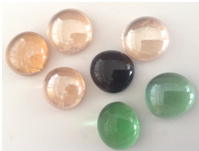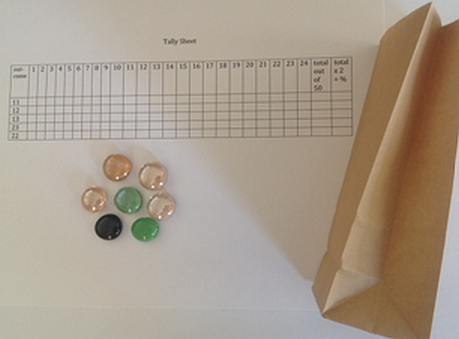
2.1. Second hands-on activity

Supplies: marbles, brown paper bag, score sheet
This time, choose seven non-rolling marbles, 4 of one color, 2 of another, and 1 of a third. You also have a brown paper bag. As before, place the marbles in the bag, close it and shake it, and draw out (without looking) two at once. Record the number of each color you got on your score sheet. Put the marbles back in the bag, close it, and shake it. Again draw out two at once, and record the colors. Continue this 50 times. Tally your scores.

2.2. Computing the probability
Now you have 7 marbles in your bag, and suppose 4 are pink, 2 green, and 1 black. When you draw out two of the seven marbles randomly, what are the possible combinations of colors and what is the chance of getting each of them?
To compute the number of ways of choosing two out of seven, we need the eighth row of Pascal’s triangle. Yes, the eighth! The first row contains 0c0, the second row contains 1c0, 1c1. So the eighth row contains 7c0, 7c2, 7c3, 7c3, 7c4, 7c5, 7c6, 7c7.
1 7 21 35 35 21 7 1
By listing all the ways of choosing 2 letters out of a collection of 7 letters, A, B, C, D, E, F and G, show that 7c2 = 21.
There are five different outcomes:
PP, PG, PB, GB, and GG.
Let’s compute the theoretical probabilities of getting each of the five.
pink green black
PP: (4c2) * (2c0) * (1c0) = 6*1*1=6 out of 21 = 6/21 = 29%
PG: (4c1) * (2c1) * (1c0) = 4*2*1=8 out of 21 = 8/21 = 38%
PB: (4c1) * (2c0) * (1c1) = 4*1*1=4 out of 21 = 4/21 = 19%
GB: (4c0) * (2c1) * (1c1) = 1*2*1=2 out of 21 = 2/21 = 9.5%
GG: (4c0) * (2c2) * (1c0) = 1*1*1=1 out of 21 = 1/21 = 5%
21 out of 21 =100%
Using the method shown in the first activity, check that the number of ways of choosing one pink marble and one green marble, PG, from the bag is 8.